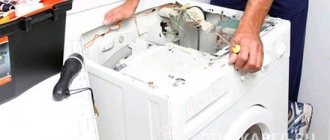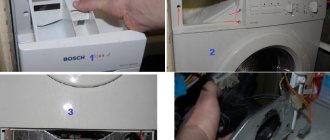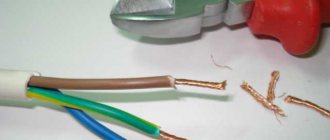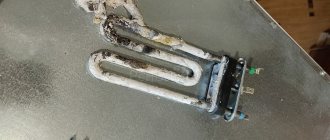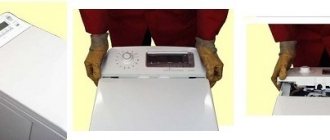Transportation regulations? It is no coincidence that new washing machines require the use of packaging for these purposes, reinforced with shock-absorbing gaskets that guarantee complete safety of the contents of the components. The mechanism of the device is sensitive to accidental shock, vibration, incorrect orientation in space, contact with moisture, etc., therefore, transportation of a device that has already been used must also be done correctly, preferably in the original box. People wonder whether it is possible to transport a washing machine while lying in the car.
Preparation for transportation
The preparatory stage of transporting SMA in a passenger car must necessarily include the following sequence of actions:
- checking the internal compartments of the device (hoses, pipes, pumps) for the presence of water in them, which can remain there for a long period after washing;
- disconnecting the drain filter and immersing the outlet of the part into a container installed below the level of the tray of the washing unit and designed to drain stagnant liquid;
- drying the internal components of the washing machine by opening the valves for a couple of hours.
Even a small amount of moisture remaining inside the device when the case is tilted can damage the electronics of the device.
Drum fixation
Experts strongly advise transporting an automatic washing machine only after first securing its drum. Poor quality of the road surface causes vibrations and pitching, as a result of which this part can cause damage to the insides of the household appliance.
Any model of washing machine comes with shipping bolts that can be used to securely secure the drum. Each transport bolt must be tightly screwed onto the rear wall of the SMA housing.
If the factory set of fasteners is lost, and the range of the nearest household appliance stores does not include this type of component, the drum can be fixed without transportation bolts.
After removing the horizontal cover of the SMA, it is necessary to place a foam gasket in the space between the drum and the inner surface of the device body. After checking the reliability of fixation of this part, the machine is almost ready for transportation.
Package
At the packaging stage, it is important to adhere to the following procedure:
- carefully twisting, wrapping in polyethylene and attaching the power cord and hose to the body using improvised means;
- fixing the detergent dispenser with adhesive tape or removing it to prevent the component from opening and falling out during transportation;
- covering the body of the washing device with several layers of protective film (if this is not available, it is necessary to take care of the external protection of the machine with blankets and materials that can act as a shock absorber in the event of a possible impact).
The packaging materials are secured on the outside with twine or tape.
How to secure the washing machine drum during transportation
An important question is how to secure the washing machine drum to ensure complete immobility. This is the most movement-sensitive and fragile mechanism. Movement in the body, falling of the washing machine - the insides will be damaged beyond repair or expensive repairs will be required.
There are two options:
- The rules for transporting a washing machine require the use of bolts - they guarantee the stationary position of the drum. Items are included as standard upon purchase. They need to be inserted into the holes on the back panel and tightened tightly. If they are lost, you can buy them at hardware stores.
- Without the manufacturer's transport bolts, you need to unscrew the horizontal panel of the machine. Place a sheet of foam plastic into the resulting cavity. It should be between the drum and the inner wall. Check the degree of fixation so that there is no extraneous noise during movement. It is better to entrust the task to carriers; in this case, you will be able to transport the washing machine inexpensively and in complete safety.
In the absence of foam plastic and bolts, you can reliably insulate the drum:
- bubble wrap;
- rags;
- soft cloth;
- foam;
- insulating analogues.
After placing the “fasteners”, screw the back panel back, additionally cover the washing machine with film and tape.
Rules for transporting a washing machine
The best option that will reduce the risk of breakdowns is auto delivery of the washing machine by an experienced company. There is a team of loaders, special equipment for lifting the unit on board, and mounting systems in the vehicle. When moving on your own, follow these rules:
Proper packaging
After fixing the drum, it is worth protecting the body of the unit. Suitable materials for this include blankets, soft fabrics, and corrugated cardboard. Cover the machine, cover it with film and install insulator sheets. Additionally, tie the equipment with a rope.
Delivery to the car
The removal of heavy equipment should be entrusted to at least two men. The position of the machine is important - straight, without turning over, sharp slopes when moving in an elevator or going down stairs. The unit is taken by the bottom panel, lifted and taken out at the same time. A caveat: only professional movers can remove the washing machine correctly.
Loading the machine
The most important stage for the owner. It is permissible to tilt the unit slightly, but do not turn it over. Carriers use special devices to lift heavy loads. Sharp impacts on the side, rocking, and dragging on the side along the bottom of the car are unacceptable.
Fixation in the car
Many people are interested in whether it is possible to transport a washing machine on its side. This is undesirable, since there is a high risk of flooding the mechanisms with residual water. Vibration will damage the “insides” and some elements may be damaged. The correct position is vertical with reliable fastening to the side of the car or with a separate crate.
If you had to lay the unit on its side, build a layer of shock absorption from soft fabrics, foam rubber, warm clothes, cardboard.
It is acceptable to place:
- strictly vertical;
- horizontally, but only on the back wall;
- on the side that is closer to the cuvette, first remove it and dry the area;
- Directly in the direction of travel of the car.
How to transport it correctly
After all fragile elements of the automatic washing device are protected from factors that could harm the operation of the device during transportation, you need to study the list of recommendations for the safe transportation of AGRs:
- when loading, the washing machine may tilt slightly towards its rear panel;
- It is not permitted to transport such electrical appliances in a horizontal position;
- the optimal vehicle option for transporting a washing unit is a small truck, the use of which minimizes the risk of damage to the body and internal components of the AGR as a result of falls and impacts;
- the washing appliance can be loaded in such a way that the machine first lies on its side and then assumes a vertical position;
- a layer of rags or other soft materials should be laid under the transported SMA, which will act as additional shock absorption when the vehicle moves;
- a passenger car (its interior or luggage compartment) is not intended for transporting such fragile large items: such a method of transportation is fraught with damage.
Transportation
There are several recommendations for transporting washing equipment.
Recommendations for carrying and loading the automatic machine
Carry the washing machine to the vehicle carefully so as not to damage it. Loading equipment must also be done carefully. Experts advise immersing it in such a way that it is in a vertical position.
Transportation methods
There are three transportation methods that you should familiarize yourself with in advance.
In a natural position
People who are moving to a new apartment must transport equipment correctly. It is recommended to immerse it in a natural position so that it stands on its legs. This will prevent damage to the side walls.
On the side wall
Sometimes people have to transport the washing machine not vertically, but on its side. This method has certain disadvantages, which include:
On the back wall
To prevent the washing machine from falling during transportation, it is placed on the back wall. However, before this, a piece of cloth is placed on the surface to prevent damage to the machine.
How to transport correctly in a car
When transporting in a passenger car, equipment is placed in the back seat, as there is more free space there. Before transportation, it is attached to the seat so that the washing machine does not accidentally fall. You can also support it with your hands for greater reliability.
Is it possible to transport a washing machine on its side?
The only correct and safe way to transport SMA involves the use of vehicles specially designed for cargo transportation in Moscow and large cities.
The internal space of their vans will allow you to transport the electrical appliance in an upright position. But the question arises: is it possible to transport a washing machine lying down? This position of the electrical appliance during transportation can only be forced when a passenger car is chosen as the vehicle.
Transporting an electrical device in a horizontal position will not lead to damage to the internal mechanisms if its body is laid on its side (on the rear panel) and securely fixed on the surface of the luggage compartment, roof or interior of the car, covered with a soft layer of shock-absorbing material. The machine should be turned sideways in the direction of travel.
Transporting the washing machine
Now you know how to pack a washing machine to transport it in a car or truck. The next stage is the transportation itself, which is preceded by transportation and loading.
Important! Think it's okay to turn your washing machine upside down while you're taking it down from your floor? In no case! If carrying is uncomfortable, maintain only a slight backward tilt, but do not invert the SMA.
Next, we decide whether it is possible to place the washing machine on its side when loading it into the car. Although such transportation of a washing machine is undesirable, it is still acceptable. If there are no other options, transport it on its side, just be careful.
You can also transport the machine in the following positions:
- standing;
- placing it on the back wall.
IDEAL transportation, according to service center specialists, is with a fixed tank. The car turns sideways in the direction the car is moving. If there are other things, it is worth clamping the machine with them. This will ensure the safety of shock absorbers, contacts and pipes.
Subtleties of transportation
Attention! Do not turn the CM over under any circumstances!
It is better to organize transportation on your side or lying down than upside down. In any case, moisture will remain in the machine, which can drain onto the control panel. Repairs will be expensive, so either dry the car before transporting it or don't turn it over.
Before transporting the washing machine on its side, if there are no bolts for transportation, secure the tank with foam rubber.
And don’t forget about the detergent intake - there may be water left in it that will pour onto the board. It is better to take out the cuvette and transport it separately from the body. If this is not possible, wipe the part dry.
Carrying on the rear wall is available for all SMA models except Zanussi. In machines of this brand, heavy counterweights are located in such a way that in the “back” position they can crush the filler valve.
Not knowing how to transport a washing machine correctly, some owners manage to carry it to the front wall. This is strictly prohibited. In this case, it is almost impossible to deliver the entire hatch and cuff to its destination.
What are the dangers of incorrect transportation?
Failure to comply with the rules for transporting household AGRs is fraught with violations that are incompatible with its further functionality. Improper transportation of the washing machine can lead to the following negative consequences:
- breakdown of the drain pump;
- the compartment for detergents falls out and the integrity of its body is damaged;
- occurrence of malfunctions in the control panel;
- short circuit of electronics due to contact of contacts and wiring with liquid;
- the formation of holes, cracks, kinks in pipes and hoses;
- shock absorber failure;
- rupture or bending of the power cord;
- the appearance of tears in the cuff.
Damage to external elements may also occur: the hatch or its hinges, the body (the appearance of chips as a result of strong impacts).
Can it be transported without bolts?
When purchasing used appliances, there may be no bolts or they may be lost.
In this case, you need to remove the top wall of the washing machine and fill the free space with soft materials.
Can be used:
- rags;
- Styrofoam;
- foam rubber
Then the upper wall is put in place and secured with fasteners. Even during rough transportation, the drum and tank themselves will not be subject to impacts and damage the internal walls.
The outer casing of the equipment is also packaged in:
- corrugated cardboard;
- stretch film;
- textile.
Expert advice
Experienced experts recommend transporting the washing machine in an upright position, while securing the drum and tank.
When transported in a truck, the automatic machine is installed sideways in the direction of travel.
If other large items are transported in the back, the car must be placed between them so that it does not move, jump, or fall. This eliminates the risk of damaging shock absorbers, contacts and pipes.
Once the machine is packaged and ready for transportation, it must be carried safely to the vehicle, which can also cause problems. The hardest thing is to lower the unit from the upper floors without an elevator.
When descending from a floor, it is advisable to keep equipment in an upright position, in the same position as it will be used.
If this is not possible, then bend backwards.
If the packaging is insufficient, there is a risk that the doors will open during transportation. Although they are closed and held in place using special fasteners, it would be a good idea to secure them with tape or rope.
The empty drain hose is wound up and secured with tape or ties. Additionally, you can wrap them in polyethylene or soft material.
You might be interested in an article on how to clean the filter in a washing machine. Read an article on how to ground household appliances here.
Loading into the car
It is easiest to load a car into a truck; questions usually arise with a passenger car.
There are several positions in which equipment can be transported:
- standing;
- on the side;
- on the back wall.
If the machine will be transported on its side, then the drum and tank may not be secured. Not all experts share this opinion, so it would not be superfluous to lay foam rubber between the mechanisms.
A used machine must be completely dry if it is planned to be transported on its side. Liquid may remain in the powder container. Getting the car body wet isn't as scary as damaging the electronics.
If you are not sure that the container is dry, it is better to wipe it dry or remove it and transport it separately.
Please note: if the washing machine is transported lying down, the powder container should not point upward (you need to focus on the model of the unit).
All brands of household appliances, except Zanussi, can be transported on the rear wall.
The manufacturer Zanussi differs in that it makes the fill valve near the counterweight. If you put the machine in an unnatural position, the valve breaks.
Before transporting the machine, you can place it on the back wall for a while to allow excess water to drain through the drain hose. Of course, the driver should drive as gently as possible and not stop or turn abruptly.
What are the consequences of violating transportation rules?
Without studying the established rules, SMA owners quite often cause significant damage to the equipment during its transportation. Even a short trip of no more than fifteen minutes can result in complete failure of the device.
What can happen if transportation is disrupted:
- the power cord breaks;
- machine parts made of plastic material break;
- the rubber cuff of the loading hatch breaks;
- the hatch fastenings and its guides break off;
- shock absorbers fail;
- rubber components are torn - pipes, hoses;
- wires and contact groups are oxidized and short-circuited;
- the selector wheel on the control panel for setting programs breaks;
- the pump that drains water loses its functionality;
- If you forget to fix the powder receiver, it can also be damaged.
Each of the breakdowns is eliminated, except for the damaged housing part or the complete loss of functionality of the electrical unit. Connecting the machine for testing is permitted after it has been completely unpacked and the bolts securing the drum have been removed. It is likely that they may be needed someday. The best storage option is in a plastic bag secured with tape on the back wall of the washing machine.
The machine should be installed in the designated place after the levelness of the floor has been checked. If this requirement is neglected, then during operation the unit may leak or “refuse” to perform the specified function.
To prevent anything like this from happening, the machine must be carefully prepared for the upcoming move and its movements from the bathroom to the new destination must be carefully monitored.
Preparing the device for moving
Before loading the washing machine, you must place it in the original box . Additional protection can be provided by padding made of foam rubber or foam blocks. This is the best option, but it is quite difficult to fulfill all the above conditions. In reality, owners keep the original packaging for several years. Then the box, and along with it the standard fasteners, are thrown into a landfill. Therefore, when transporting the device, you will have to make do with improvised means.
Transportation of the washing machine is carried out as follows:
- Disconnect the device from the electrical network and water supply.
- Drain any remaining water from the drum, hoses, pipes and other elements of the system. Pay special attention to the drain pump. Water that has not been removed from the machine can cause problems during transportation.
- Immobilize pipes, wiring, hoses and other moving parts. You can do this with tape or plastic clamps. Loose parts may be damaged when carrying and loading the washing machine.
- Pre-treat the protruding parts of the device with tape. This will ensure greater safety of the external parts of the device and the surrounding environment. Protected edges will not injure movers and will not damage the packaging.
Next, you need to fix the washing machine tank in one position. Here you cannot do without standard transport bolts. They are mounted on the back or top panel of a household appliance.
If they were lost, you will have to do without the transport elements and dismantle the top cover of the washing machine. This is necessary for laying insulating foam rubber in the space between the tank and the panels of the machine. You can also use foam parts, rags, etc. for this. After completing this procedure, securely screw the top panel.
Having ensured that the tank remains stationary, do not forget to protect the outer walls of the machine. Wrap them in soft cloth and secure everything with a secure cord. Having performed all these steps, you can be sure that the automatic washing machine will calmly survive the upcoming transportation. The main thing is to carefully place it in the car and not tip it over.
Preparing SMA for transportation
Before leaving, take care of your packing. The best option is an original box, in the walls of which you place sheets of foam plastic or foam rubber pieces. Of course, the washing machine may not have lasted more than 2 or 3 years, which means that the original packaging cannot be found, not to mention the fasteners and other components. You will have to get out on your own, improvising with what you have. When preparing the unit for transportation, follow the recommendations of specialists:
- Disconnect communications: electricity and hoses connecting the device to the water supply and sewerage.
On a note! Technicians have recorded cases when, in a hurry, the car begins to be pushed and moved, forgetting to unplug it from the socket or without disconnecting the hoses.
- Drain the remaining water from the SMA. It can remain in hoses, pipes, powder containers and pumps. When transporting, especially on its side, it will definitely spill, creating inconvenience and a dangerous situation for the machine itself.
What is the danger? If water spills, it can get on the control board, which is why the electronic panel runs the risk of being damaged. Expensive repairs or the purchase of new equipment await you.
- Secure the power cord and hoses with the latches provided on the housing. If they are not available, use improvised materials - adhesive tape, electrical tape.
- Using a roll of tape, wrap around the sharp protrusions of the case. Secure the powder pick-up so that it does not fall out or break.
- The last stage is fixing the tank. During a long move to another city, the tank is secured with transportation bolts, the purpose of which we wrote about earlier. If they are not preserved, they will have to be transported without shipping bolts. To do this, the CMA cover is dismantled, and foam or foam pieces are placed between the tank and the body to secure the drum located in the tank. Then these nodes will not be damaged by vibrations. You can also use cardboard, unwanted clothes, etc. Then the lid is screwed into place.
How to pack SM when moving if there is no box from the store?
After the procedures, wrap the equipment in fabric (an old blanket will do) or film with “pimples” and secure with a cord or rope. Having done everything carefully and correctly, you can easily transport the automatic washing machine without harming it.

